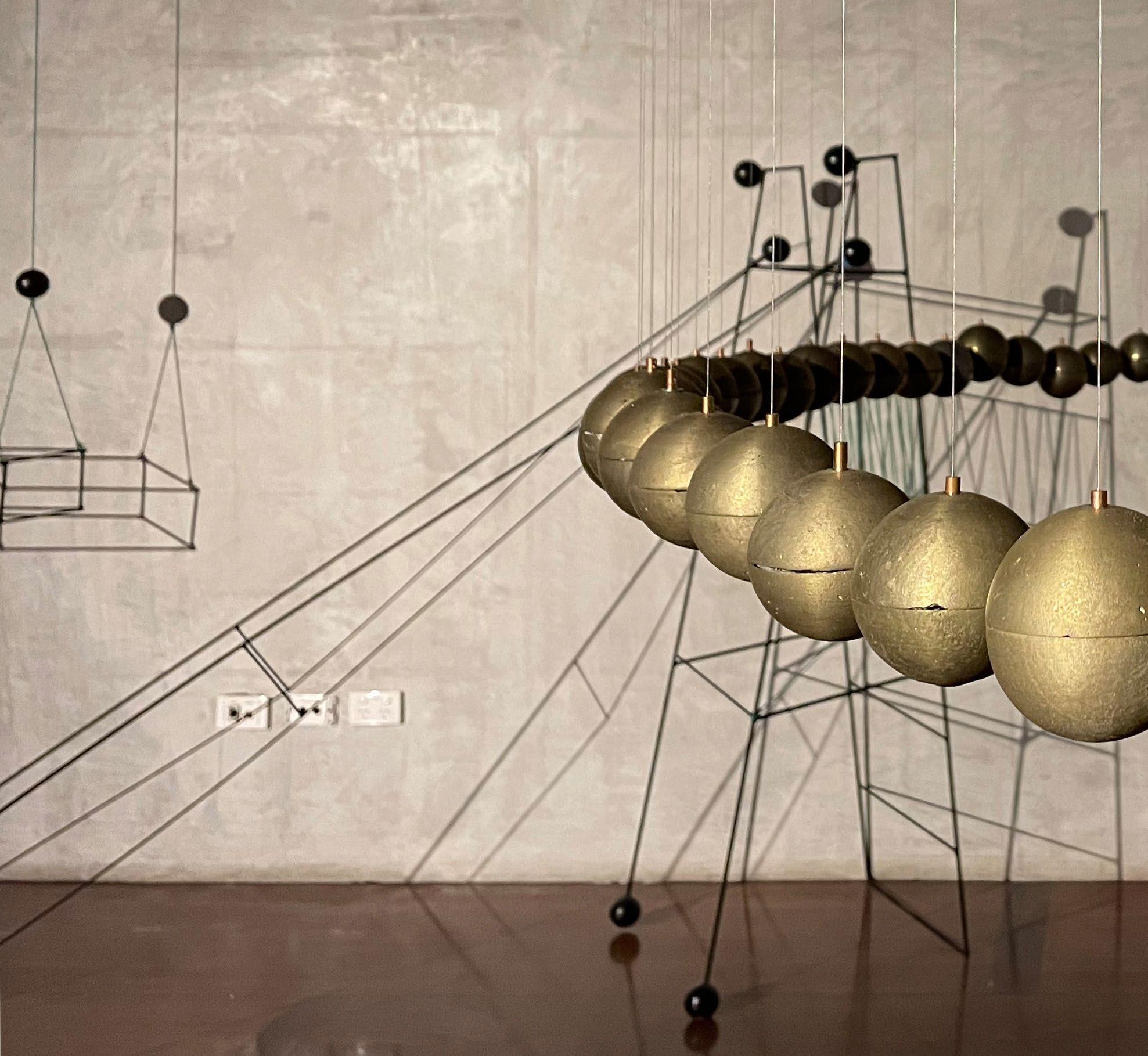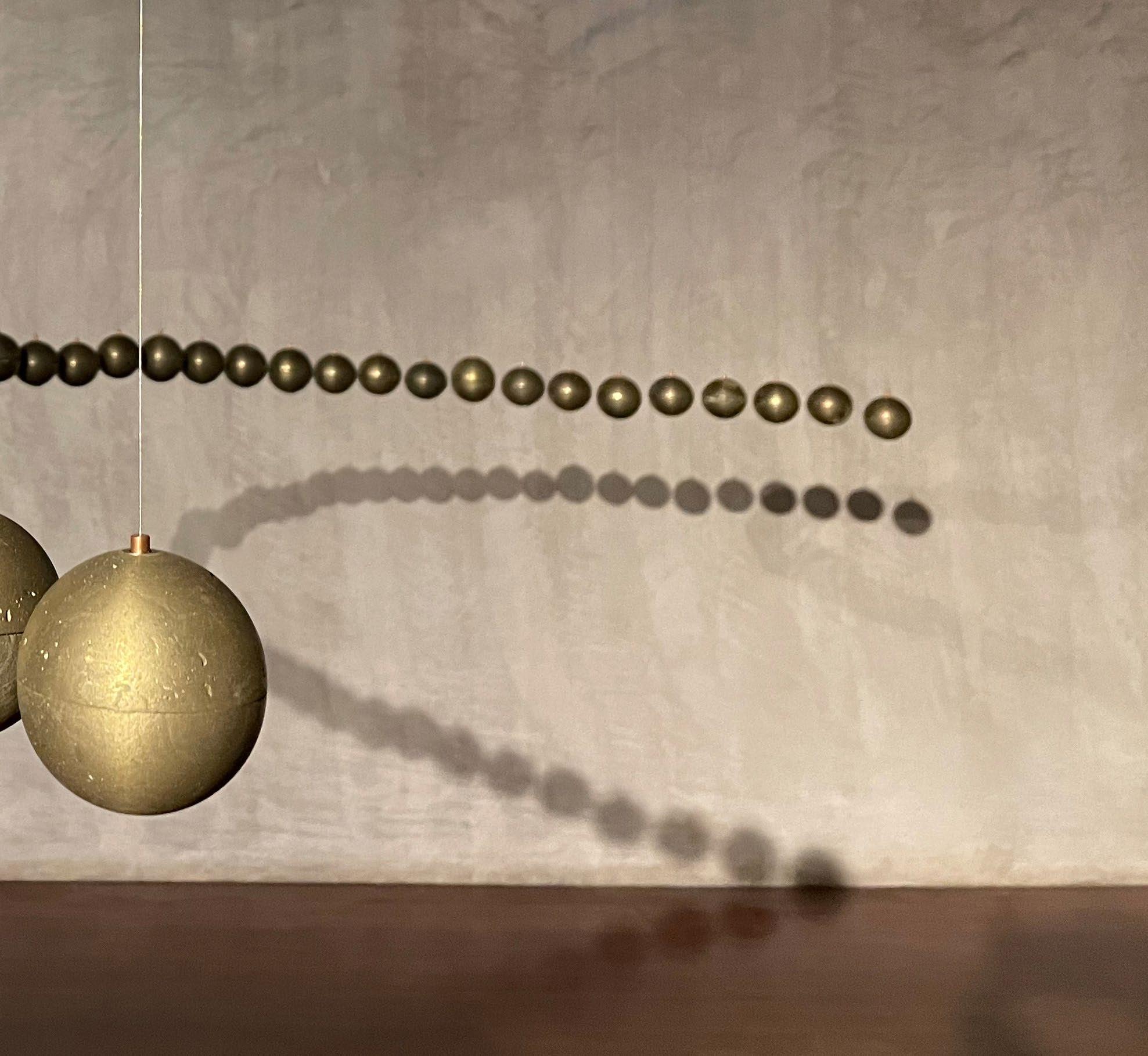
13 minute read
Fine Arts

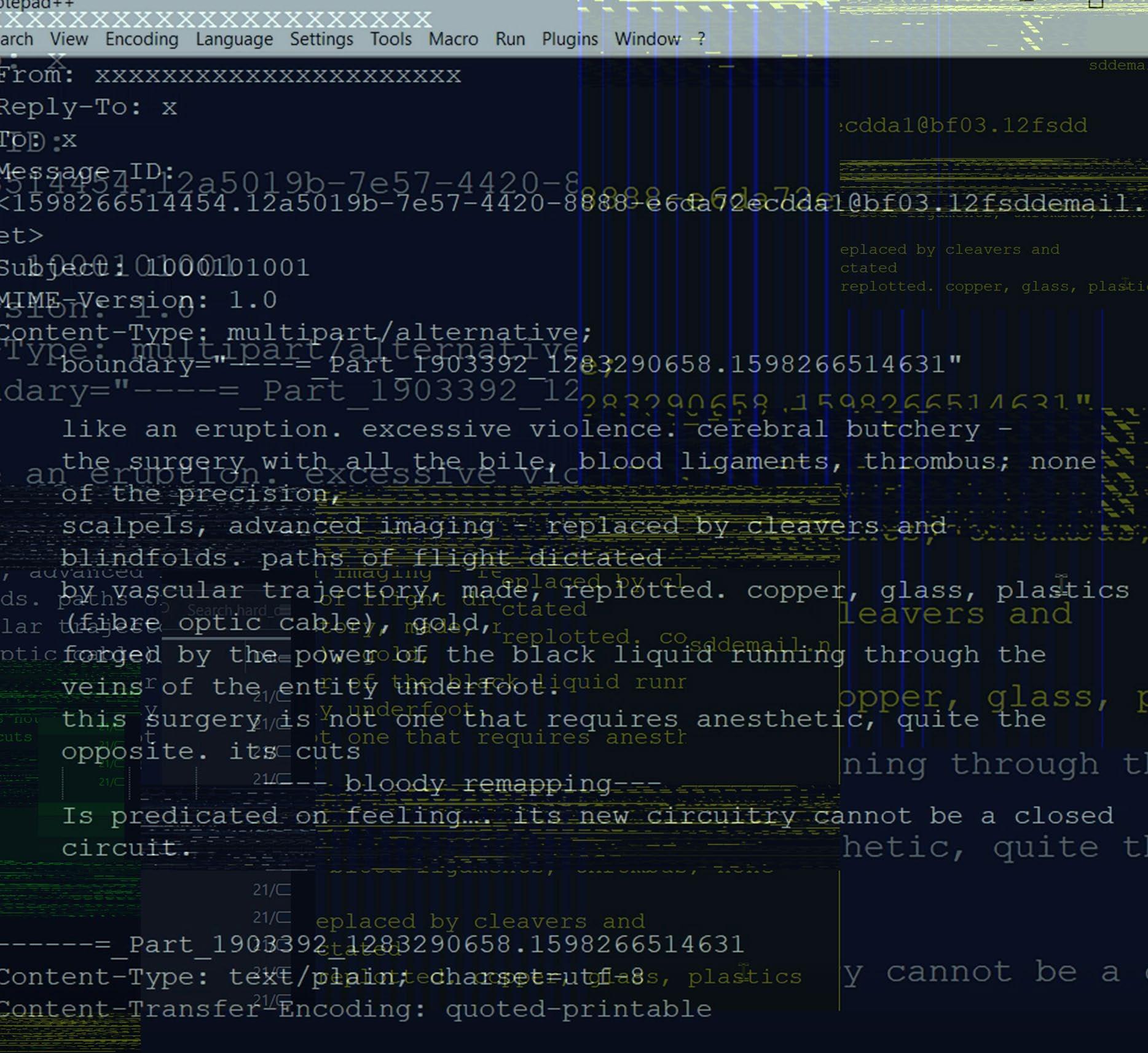
Advertisement
first slowly, then all at once, engages with the doubled function of ecstasy and paranoia as it emerges from the transgression of the subject. Within the constructed world that is first slowly, then all at once the audience is encouraged to engage not only with the boundaries that exist in limiting the human (to its discrete, whole form) but the slippages and tensions that exist within and as a result of these boundaries. Through the depiction of an ambiguous decent into monstrosity, the audience is implicated in these tensions and asked to question the elation that is derived from such a transformation.
Image: Chandler Abrahams. first slowly, then all at once. Installation, video, sound. 2020.
FINE ARTS HONOURS Unit Coordinator: Dr Ionat Zurr
DALE BUCKLEY
An Offering examines the enduring soft power of the physical art object. In an age of apocalyptic thinking and post-truth politics, making visual art as a political gesture can feel like a futile act. But across history, there have been many precedents to the current moment in our empire. The works in An Offering are broken iterations of art produced at the end of previous empires, stripped of context and abstracted to be looted tokens of cultural capital.
While our end may be in sight, a new empire will take our place. This work is addressed to that future.
Image: Dale Buckley. An Offering. Carrara marble, foam, aluminium, glass, bronze, wax, bitumen, hemp, turquoise, jet, bone, steel. 2020. Photography by Nick Mahony.
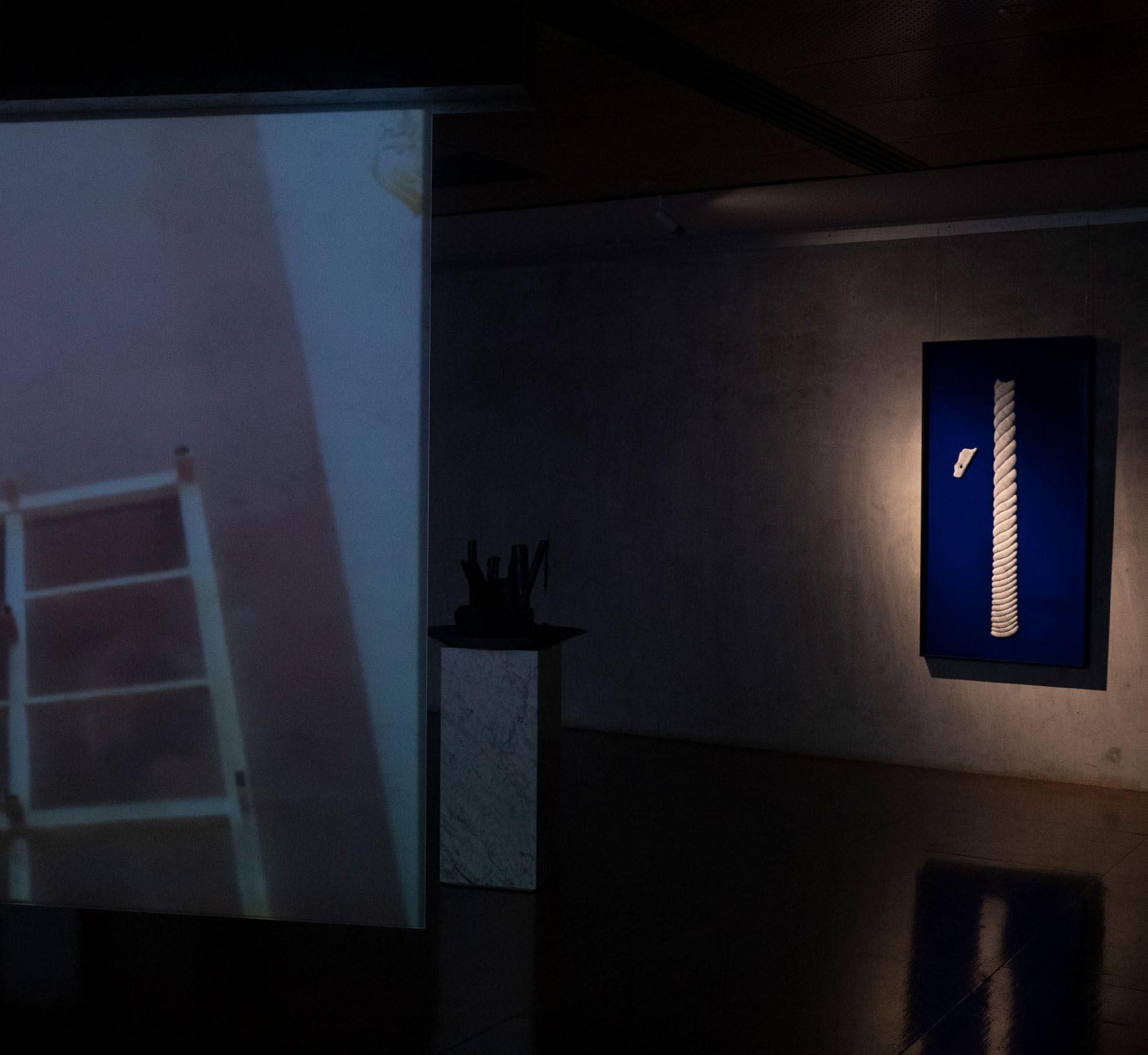
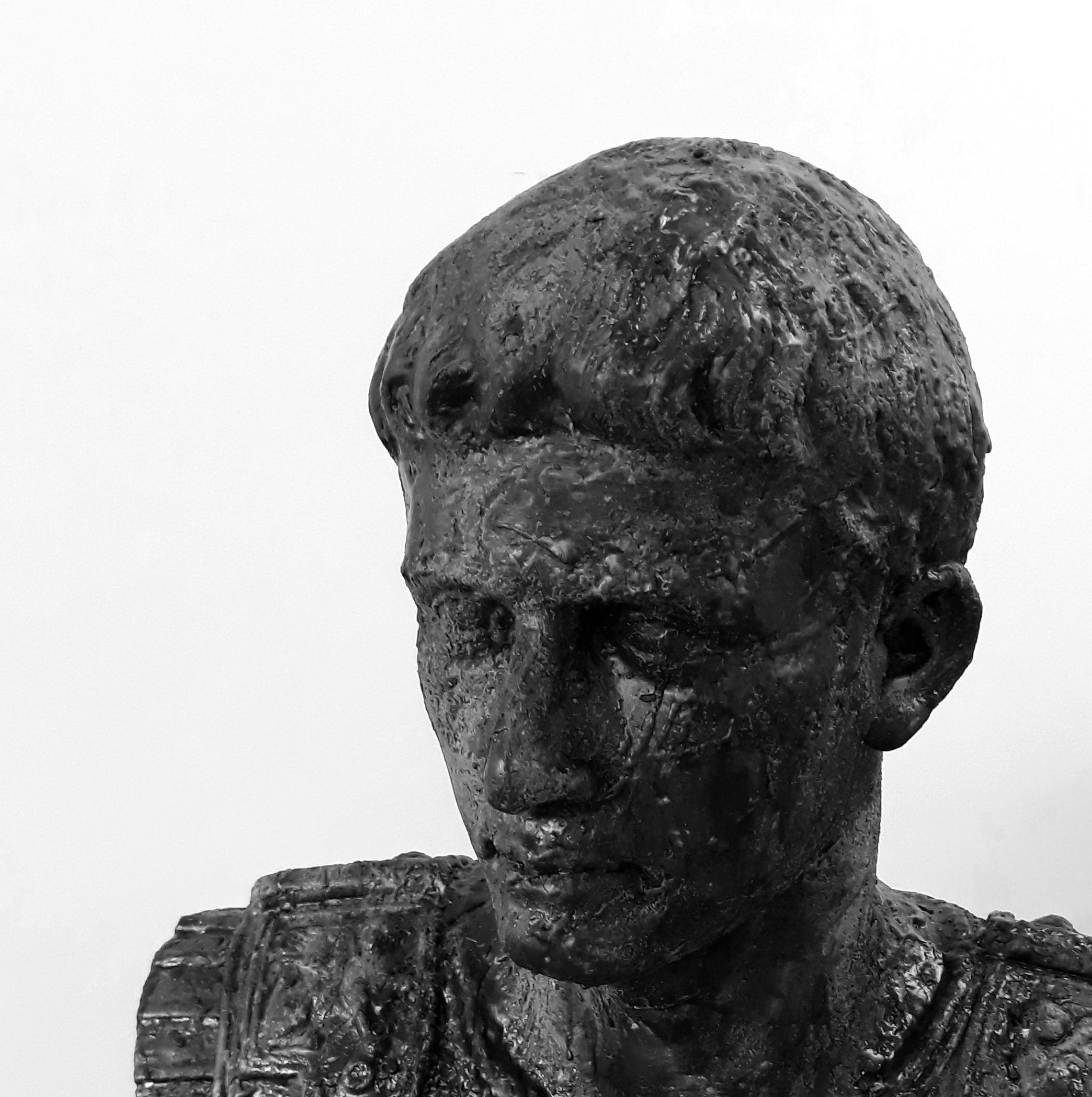
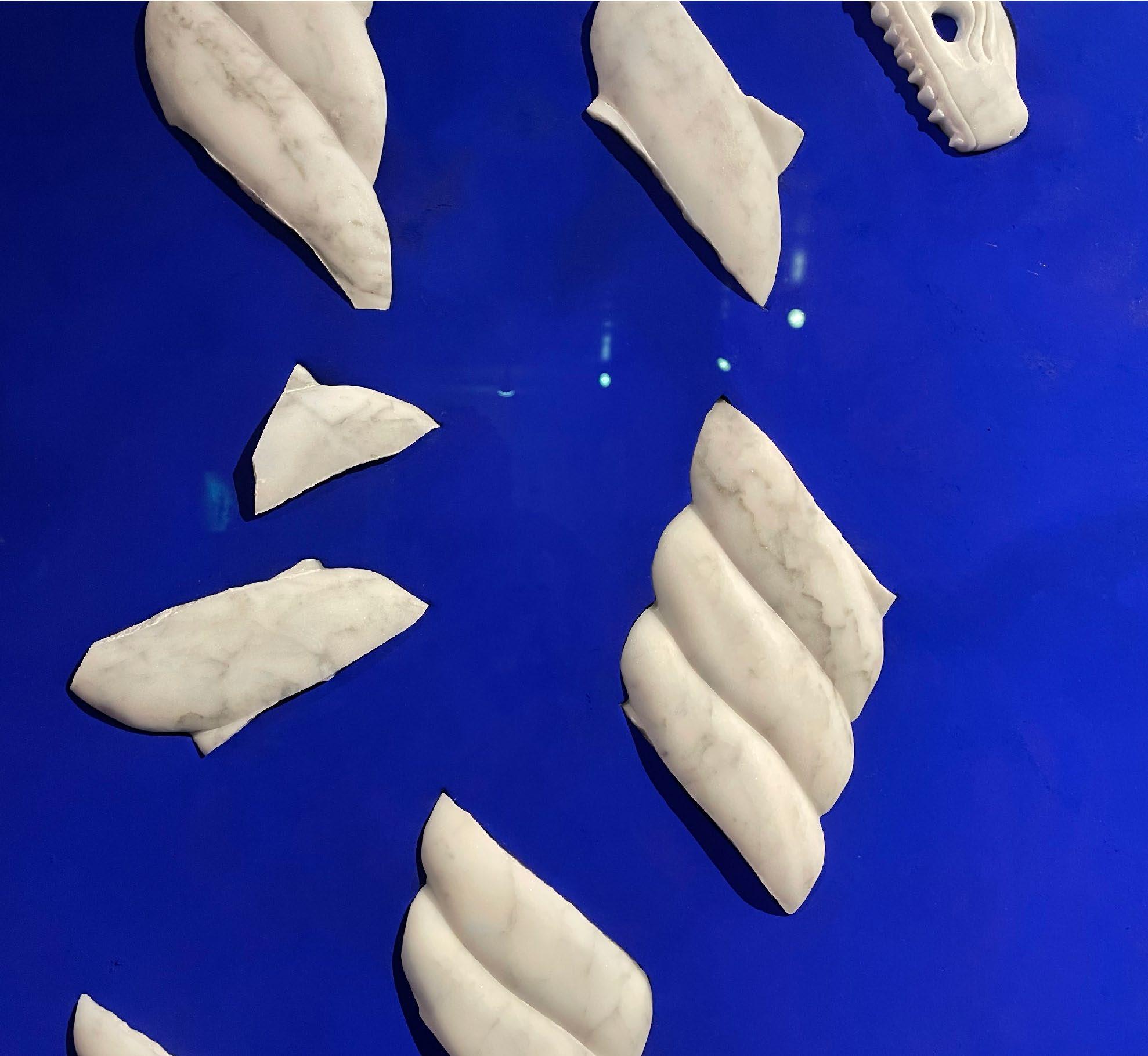
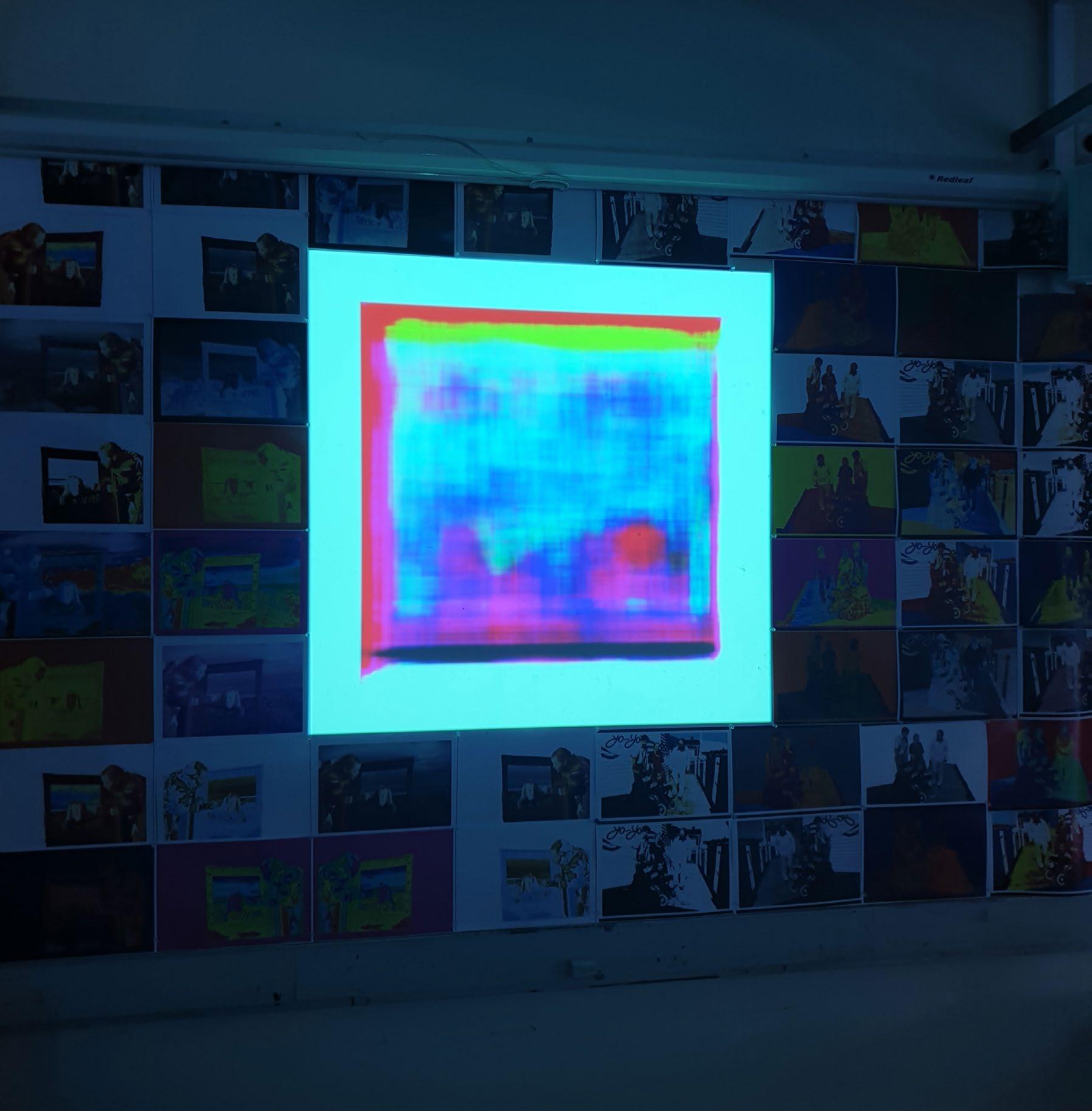
VISA3050 ADVANCED STUDIO Unit coordinator: Paul Trinidad HAMISH NINYETTE MACLEAN
Hamish Ninyette Maclean’s practice utilises AI generative technologies to explore the erratic and unstable nature of memory. Through his work, Hamish explores his minimal relationship with his late mother, employing neural networks in order to interpret old memories and recontextualise them to create new photographic links to his unexplored maternal relationship. Mantle of Memories furthers this, studying the causal links between photographic recordings of events and how they work to inform and condition recollections of past events. The piece depicts a memory-like process in which selected family photos have been manipulated and transformed only to be pushed through the lens of a generative adversarial network (GAN), reinterpreting them and forming a live recall of the memory in flux. This newly-formed memory then has stills extracted from it only to be mounted and housed within a cacophony of picture frames arranged in an erratic manner, cascading out of the confines of the plinth and onto the surrounding floor.
The installed system is made up of three components: a projected series of live recordings of a GAN trained on a dataset of manipulated family photos, the wallpapered family photos that comprise the dataset surrounding this projection and the overflowing plinth of memory frames. The live GAN is the core of the piece informing the other elements of the work, this component suffers heavily from a phenomenon known as ‘mode collapse’ in which a GAN will fail due to it analysing and basing itself on a most occurring component that is not visually recognisable in the original dataset, this unfavourable outcome is somewhat evocative of the realities of memory recall as so often are the components of memory obscured by the unintentional recollection of an insignificant factor of the event being recalled.
Image: Hamish Ninyette Maclean. Mantle Of Memories. 2020.
Zoë Sydney’s work draws from personal writings and stories to explore the experience of lesbian womanhood in Australia. Found objects commingle with unusual materials across a broad series of work, with a clear sense of connection between identity and presentation. A combination of non-traditional textile work, preowned objects, and even her own hair are used. Pinkness, blondness, girlishness are all employed as devices of artifice in a display that demands the audience present themselves to the work as much as the work is presented to them.
Image: Zoë Sydney. Don’t take it personally. Found object, mixed media, human hair. 2020. Photography by the artist.
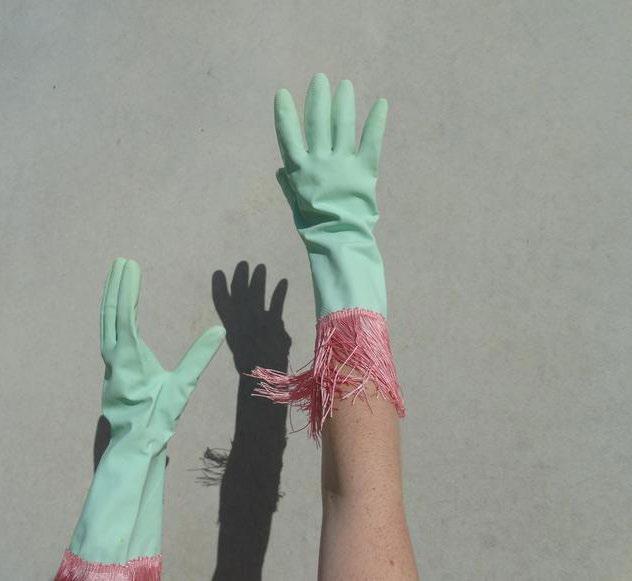
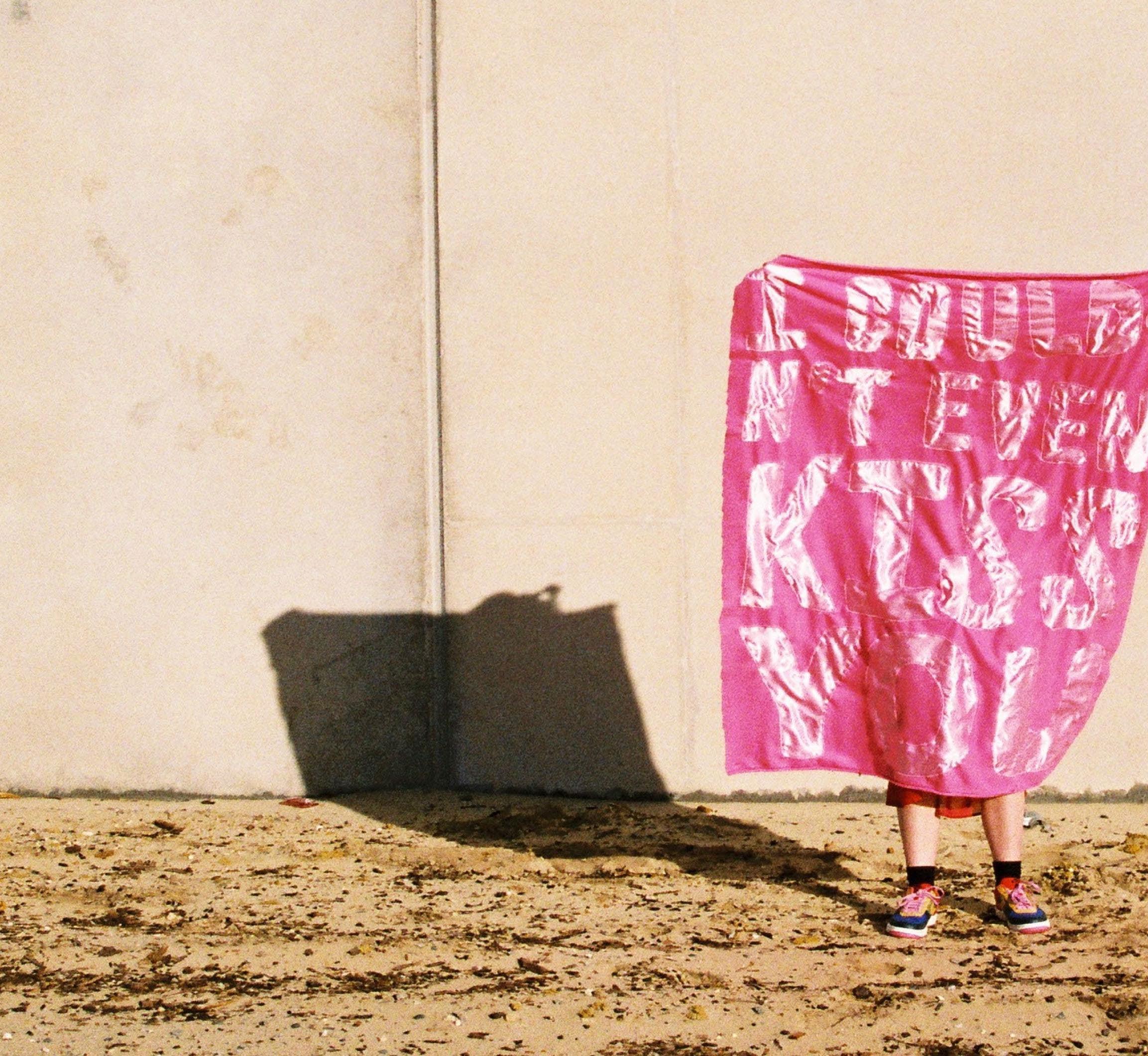
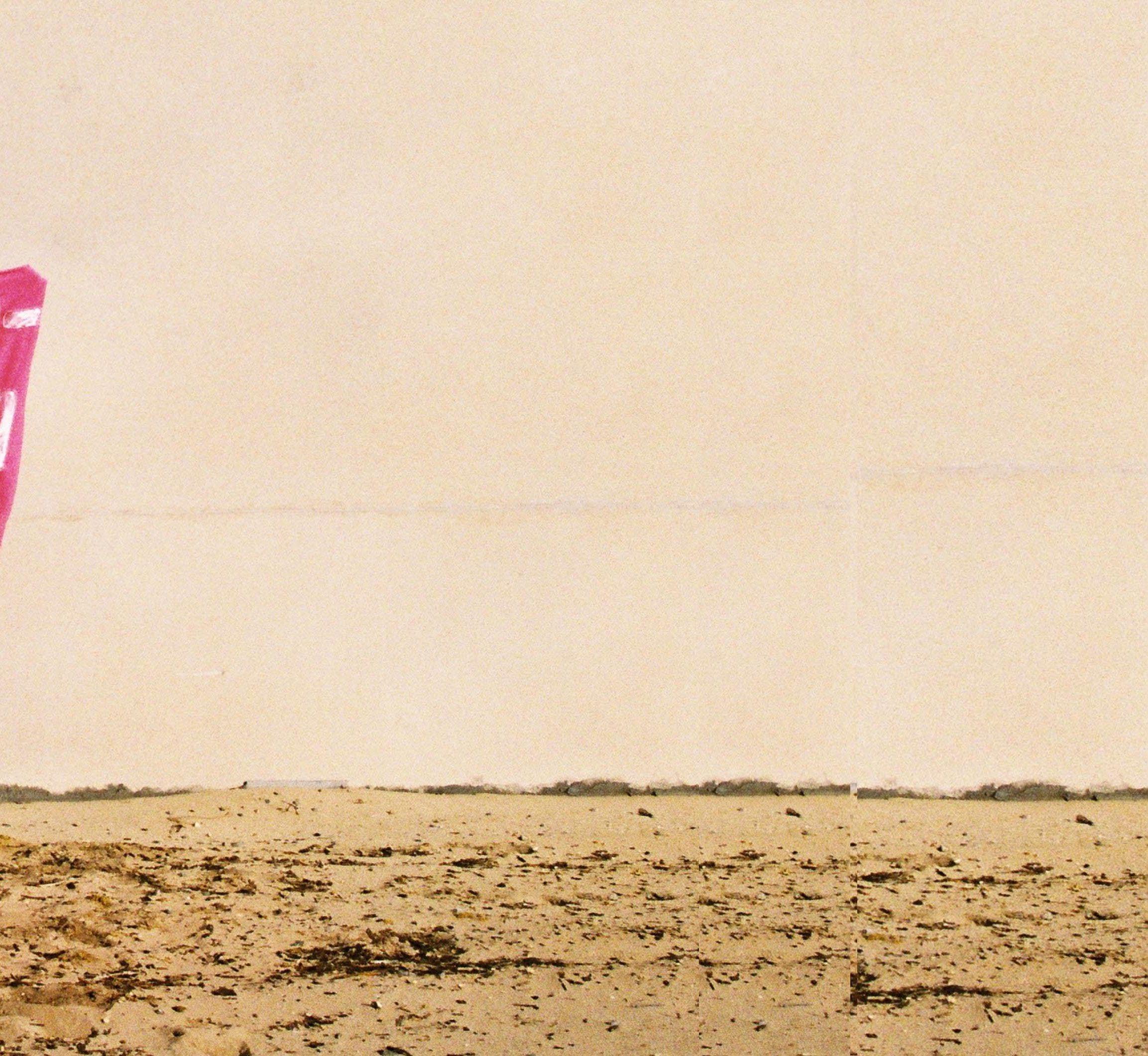
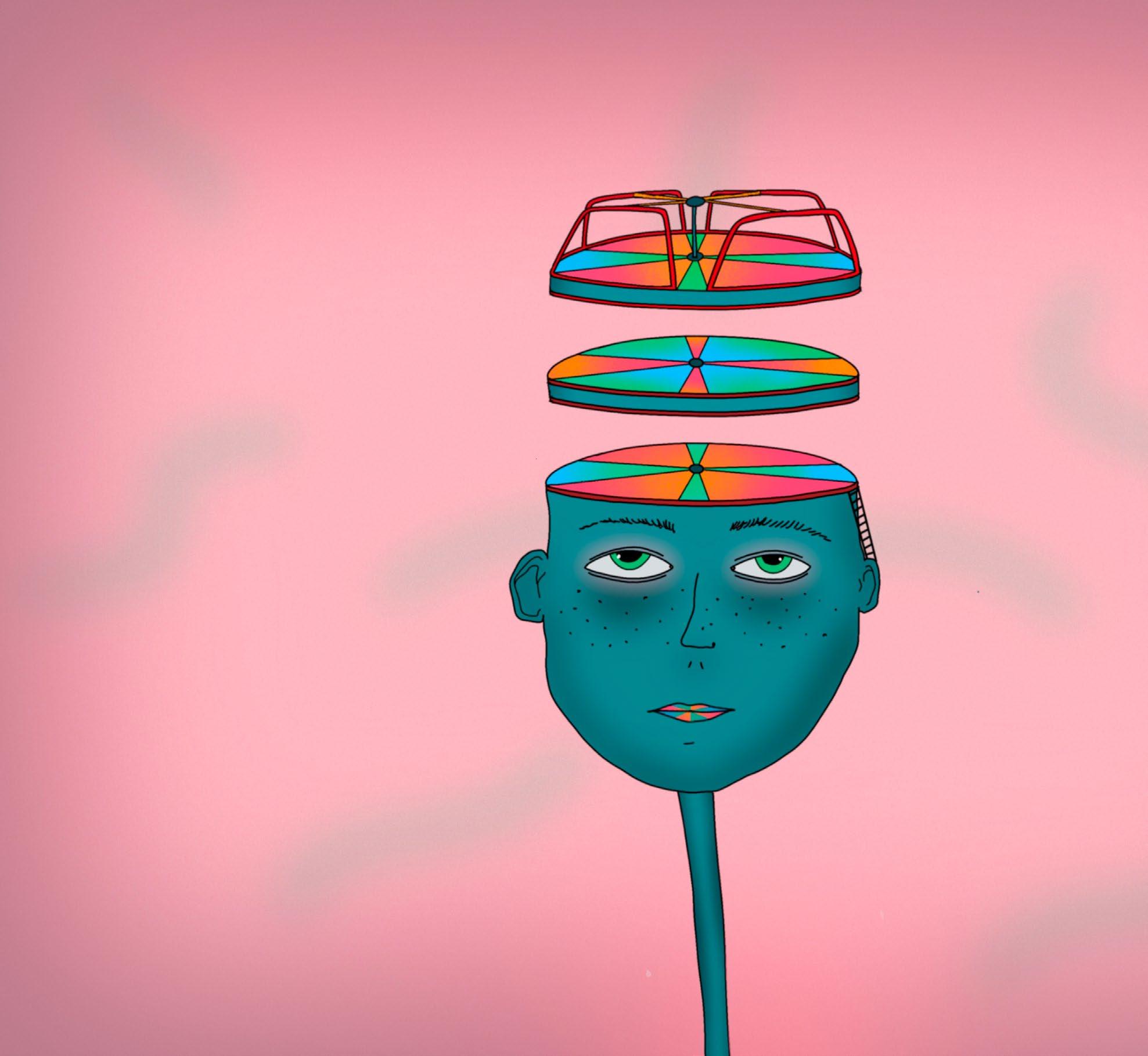
When did I change? seeks to unlock the inner knowledge of childhood. The digital illustrations are an echo of time passed and a visual prompt for reflection and reconnection to our playful and uninhibited selves. The intention is to evoke a poetic engagement with imaginative realities that exist beyond the boundaries of constructed expectations.
Image: Julie Ziegenhardt. When did I change?. 2020.
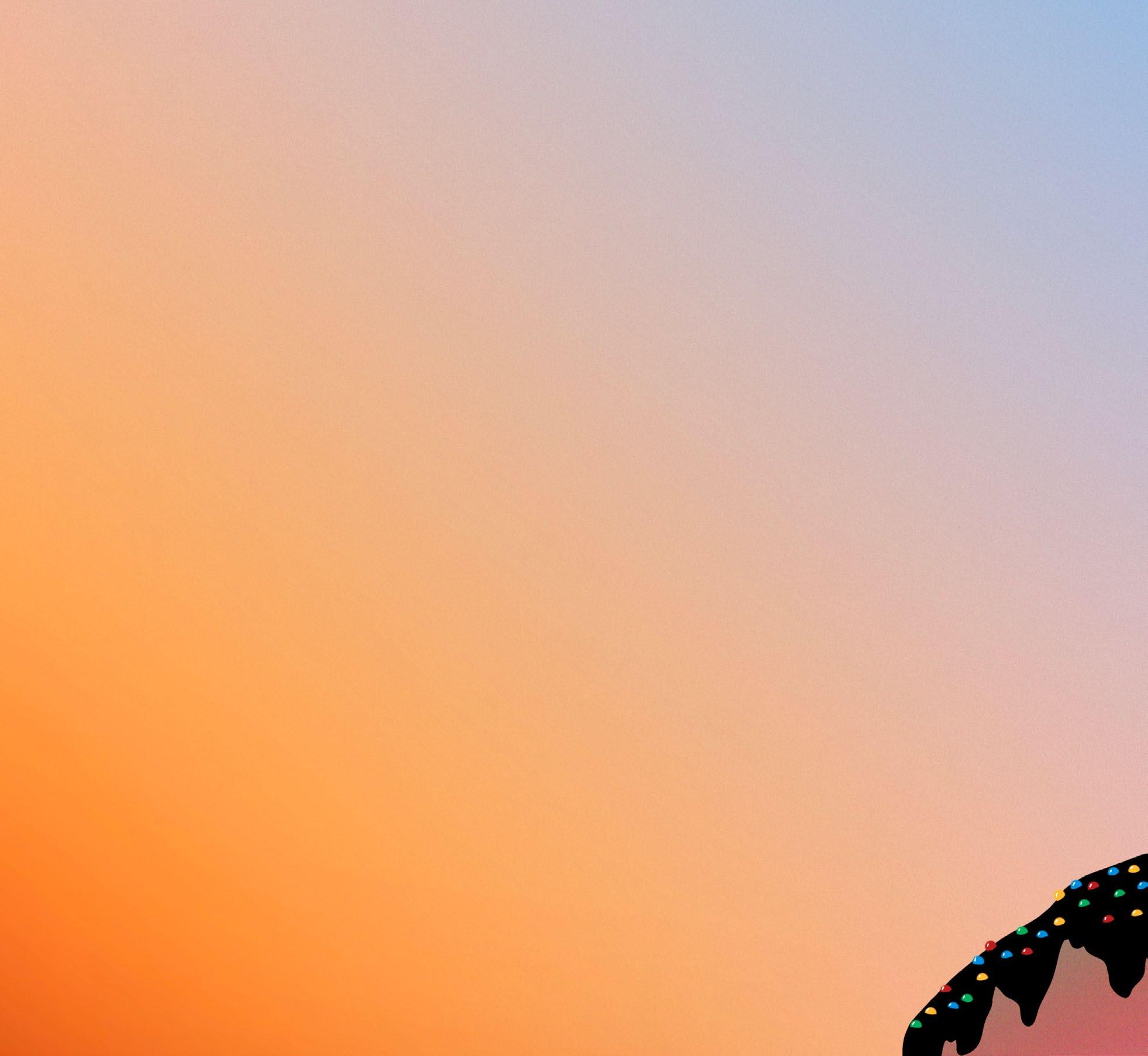
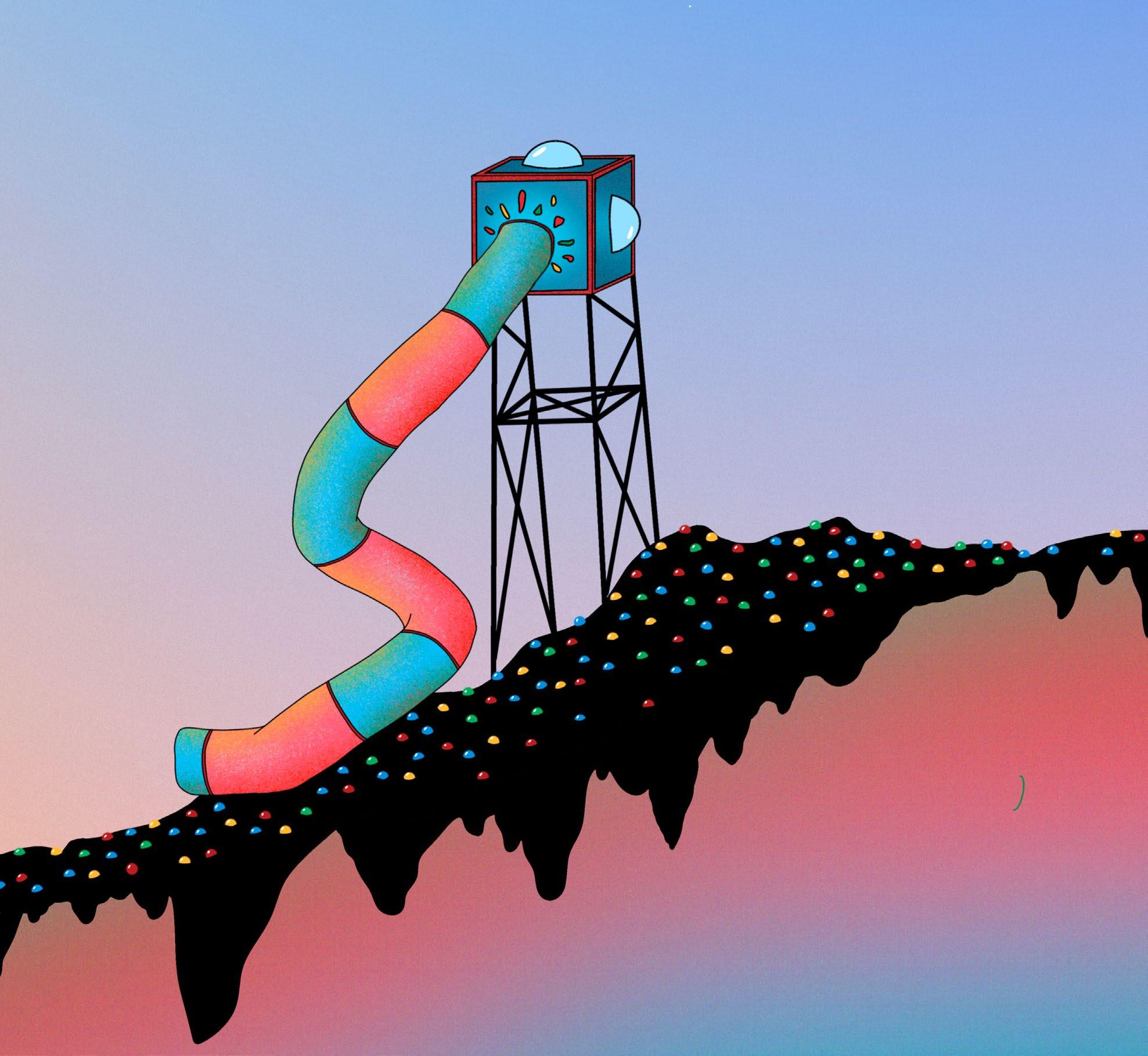
The work Hidden Vista is an exploration into current communication systems, commenting on the speed of distributed information in hyper-simulated society. The captured work rests in a place of transition, amongst industrial development, a signifier of human intervention and transaction. The surface of the earth is delicately touched in a durational display of temporal ecological manipulation. The soil then finds its own course and dissipates, accentuating impermanence through subtle labour, commenting on the transience of place. The work can only be seen from an aerial perspective, commenting on ideas of sovereignty and surveillance. https://vimeo.com/491210267
Image: Pascal Hutchinson and Harrison Riekie. Hidden Vista. Digital Print 2020.
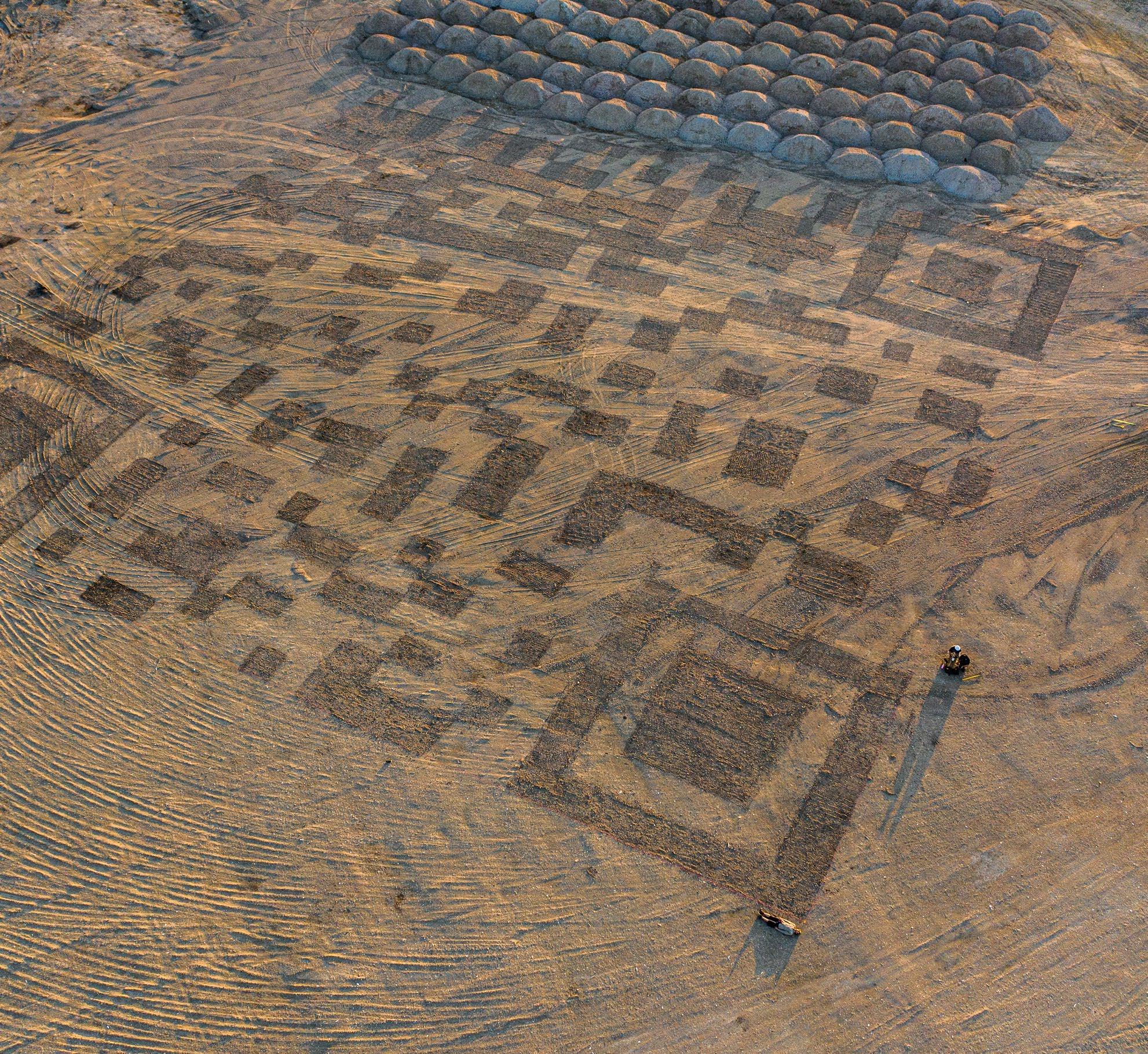

When thinking about what to create on the assigned topic of ‘Intimacy’, my first (and only) thought was of the Basal Cell Carcinoma (BCC) living in my philtrum: we had definitely been intimate for some time, though I had only just found out about its presence there and the consequent need for plastic surgery to remove it.
I started my research by thinking about the history of plastic surgery, used initially to correct ‘deformities’ such as cleft palate, then for ‘cosmetic’ (perceived) problems such as small breasts, and more recently for a deliberately ‘plastic’ look, and even more recently for ‘selfie’/’zoom’ optimisation. Plastic surgery was also investigated as an aesthetic by ORLAN who underwent nine performative operations in the early 1990s. She was the “…first artist to use surgery as an artistic medium”. My research, by necessity, included the timeworn tropes of beauty, femininity and ageing.
Post-operatively, I knew both my philtrum and Cupid’s bow were gone, and the artwork then became a grief for my philtrum. Feeling sad that it had to be sacrificed for my wellbeing. Coming to terms with a confronting type of surgery – literally ‘in your face’. Playing around with various (silly) props while taking photographs was a light-hearted way of starting to connect with my ‘new look’ (just six days post-op – it will evolve considerably over the coming months). The visceral quality was also underlined, especially with the grevillea and blowing bubble gum shots. And the flowers added an element of beauty/poetry, but also a tension. I wanted a tight crop with an intimate feel with the photograph’s maximum life-size. I had originally visualised Polaroids, as I thought this aesthetic would suit the subject, but could not organise this in time.
In conclusion, I feel that using a highly personal experience as the basis for an artwork was helpful in ‘both directions’, that is, emotionally as well as creatively.
Image: Eleonora Brusasco. Untitled. 2020.
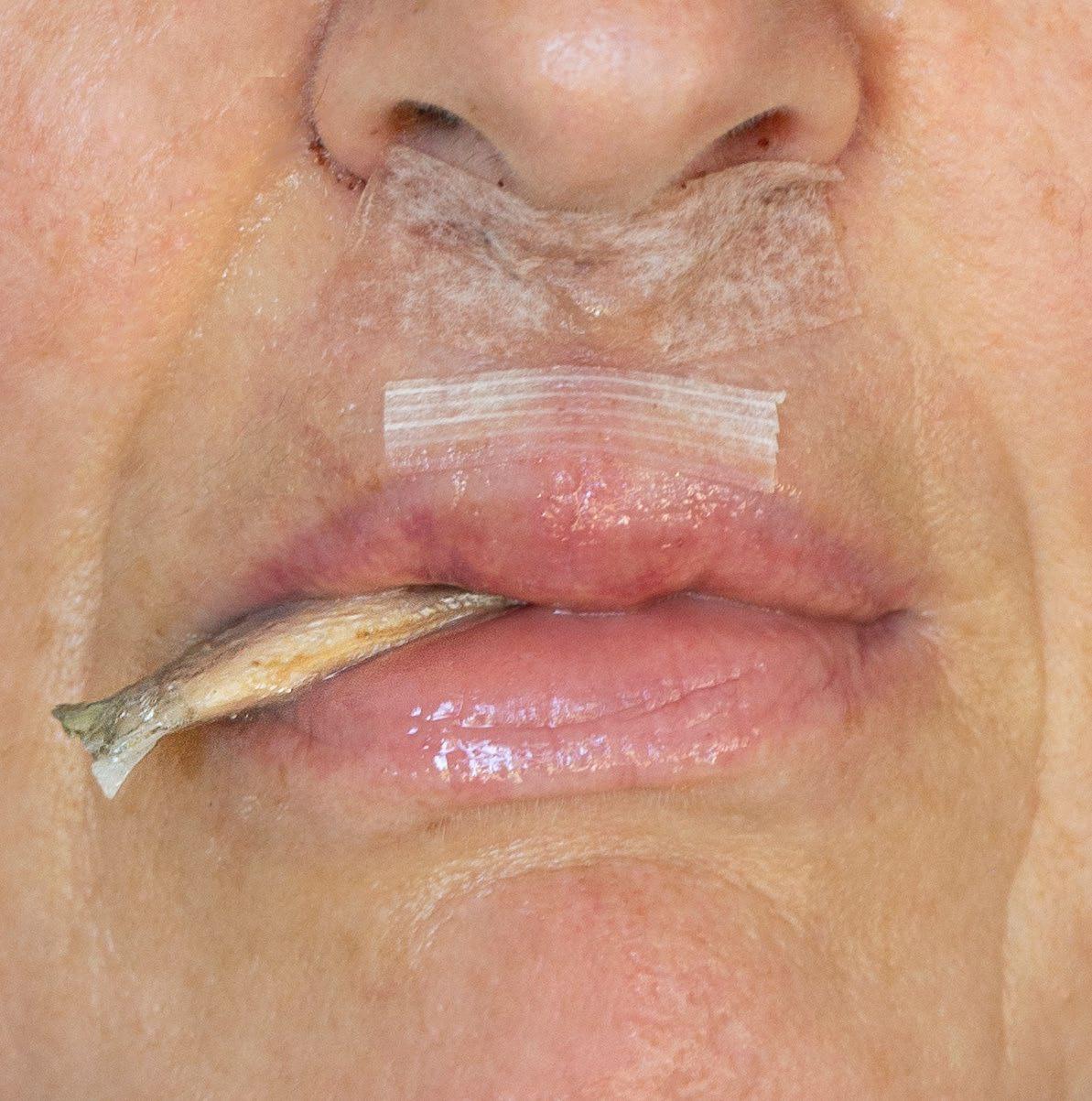
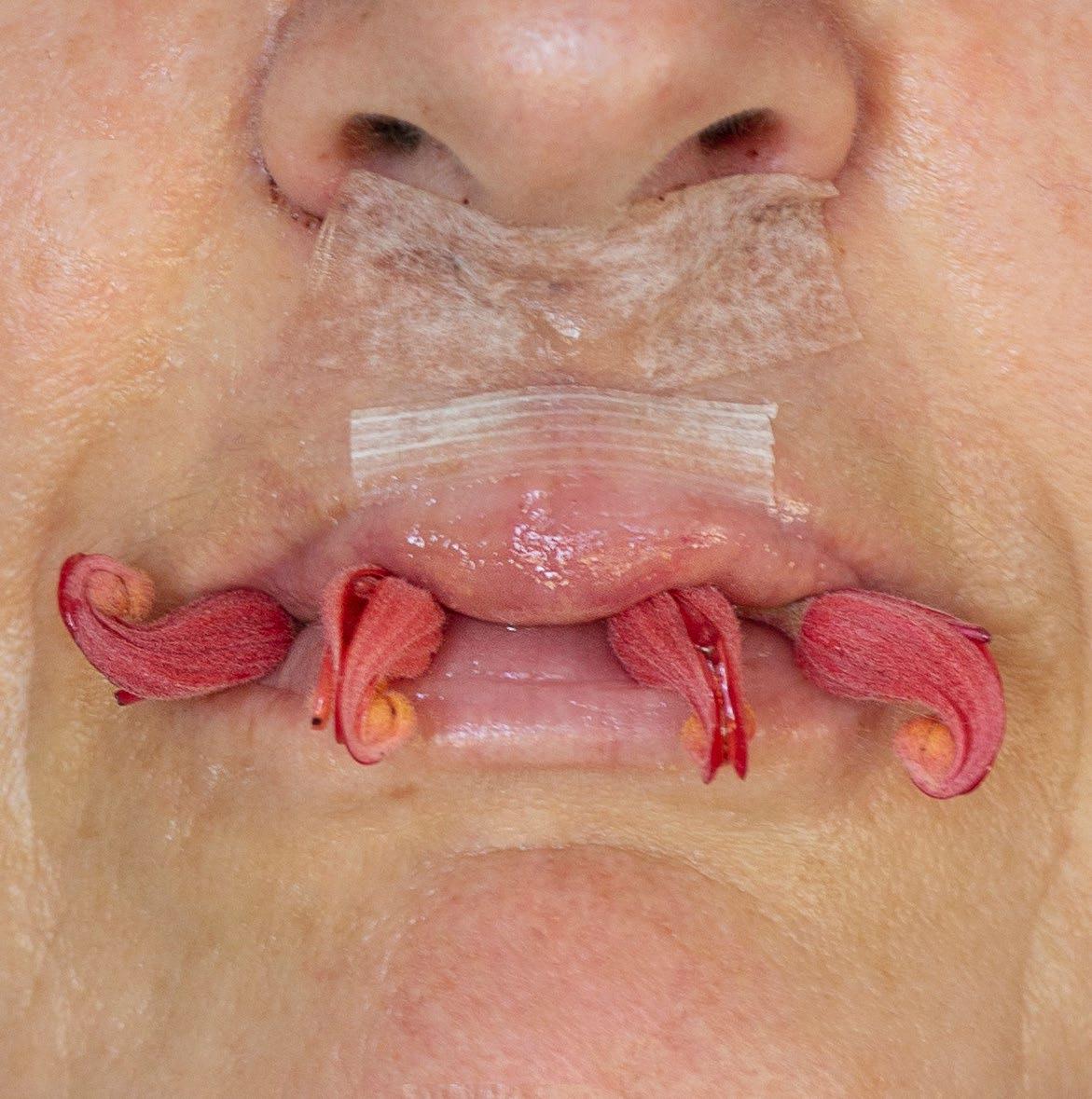
Organ Plants is a series of digital drawings depicting a bizarre future world. Human organs are merged with plant life and grown in pot plants in a hospital. This series developed from ideas regarding stem cell research and genetic engineering. Scientists have experimented with merging human tissue with organic material. While there has been no success in growing a working organ, this inspired the idea of a future where organs are literally grown on plants. The first idea that came to mind was of a heart growing on a tree. It reflected fruit that grows on trees and some ethical questions came to mind. Does the apple belong to the tree? And what is the relationship between farmers and forestry? The drawings were envisioned to be a mix of representational and surrealist styles. The digital drawing application Paintbrush helped achieve the 2D retro aesthetic I was hoping to recreate. Each drawing shows a different organ being grown: a heart, a pair of lungs and some kidneys. To accompany the drawings, a real pot plant was displayed, showing the severed plant featured in drawing three. This was fairly easy to source, with a ceramic pot, already owned, filled with dirt and a stick placed inside.
Image: Ben Nixon. Organ Plants Artwork 1. Digital drawing. 2020.
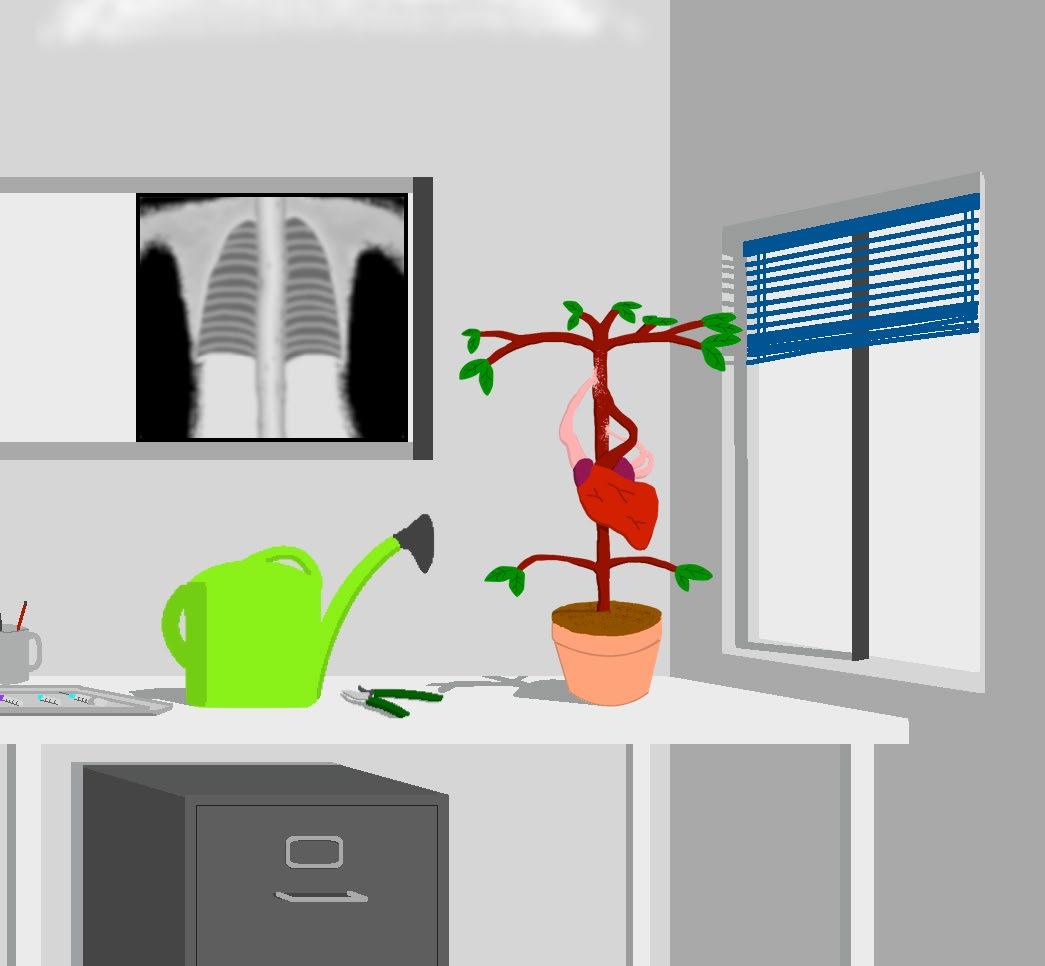
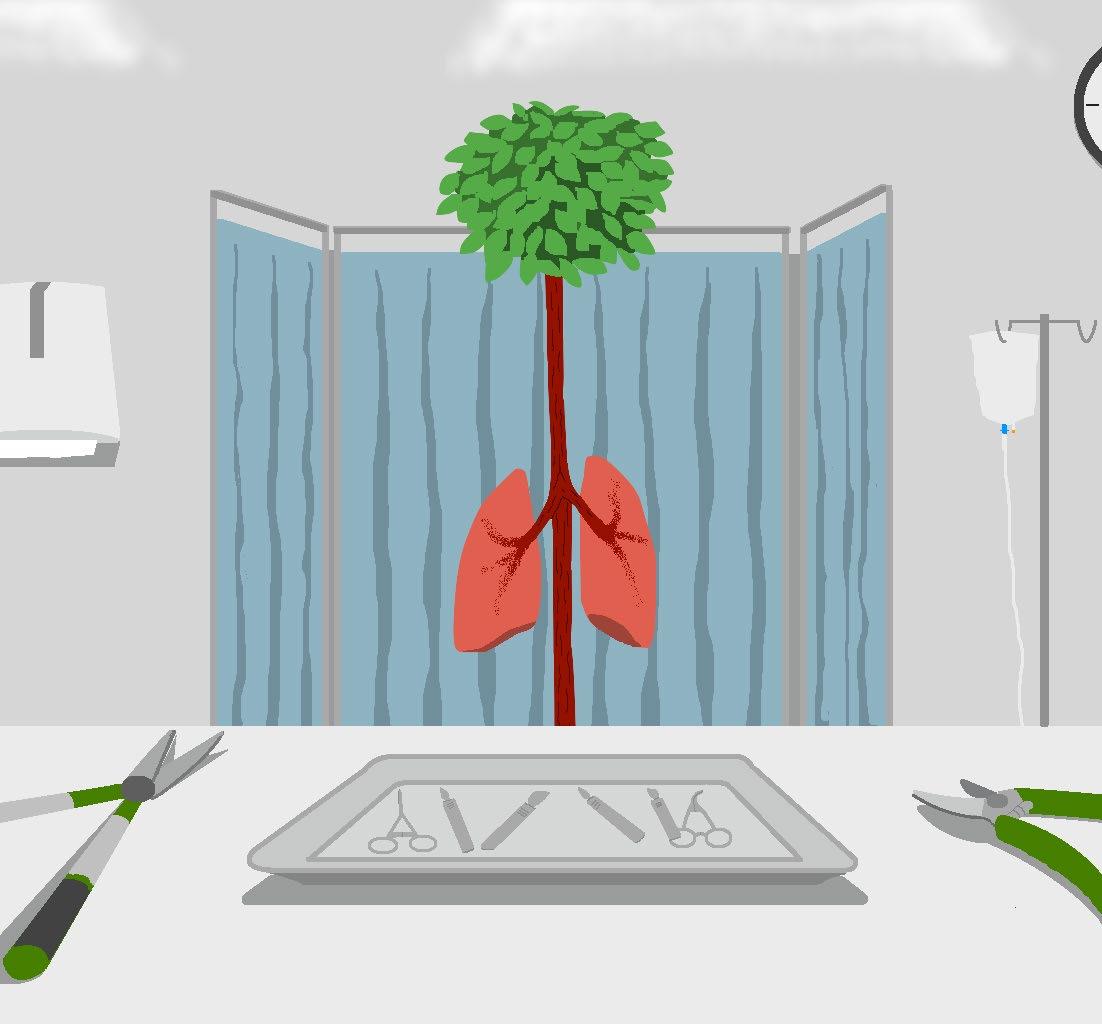
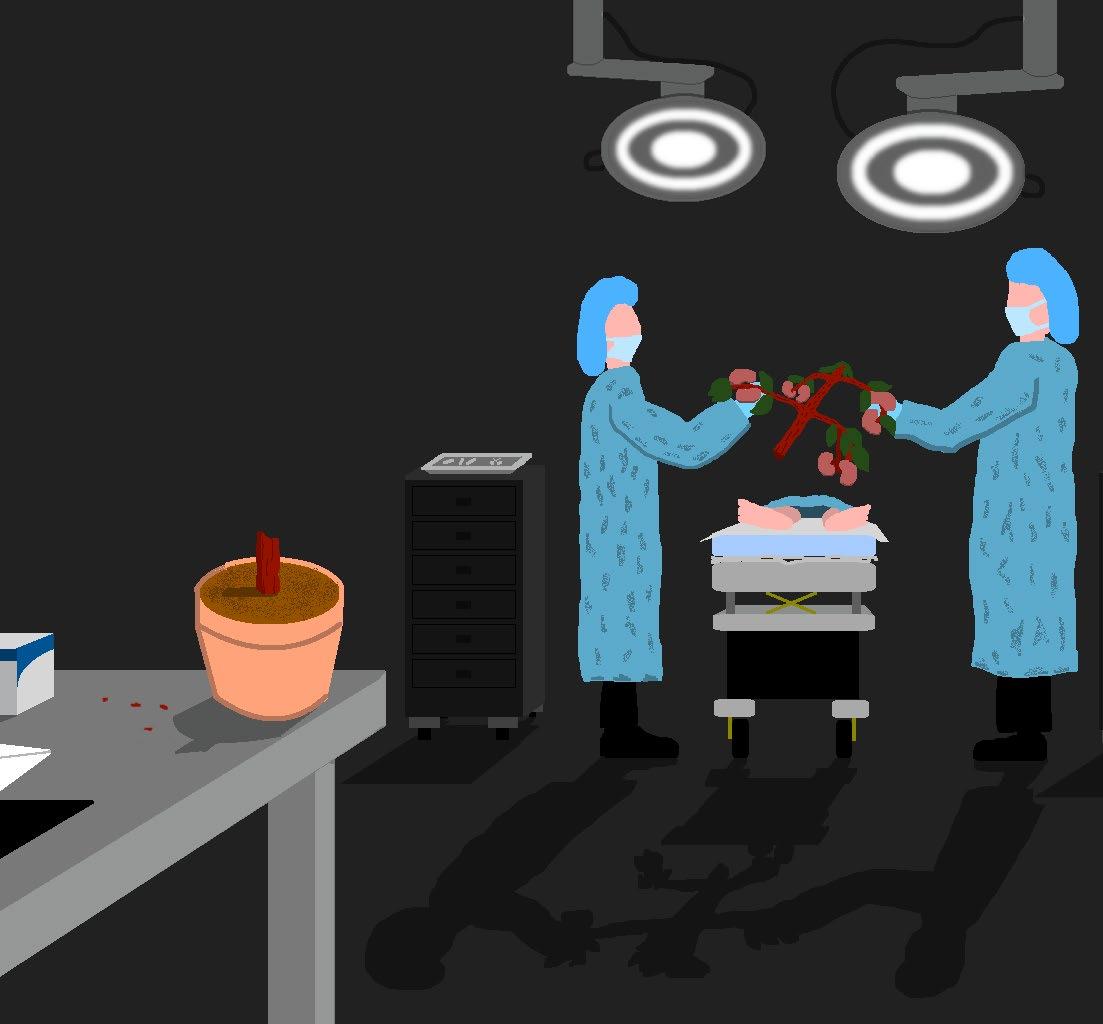
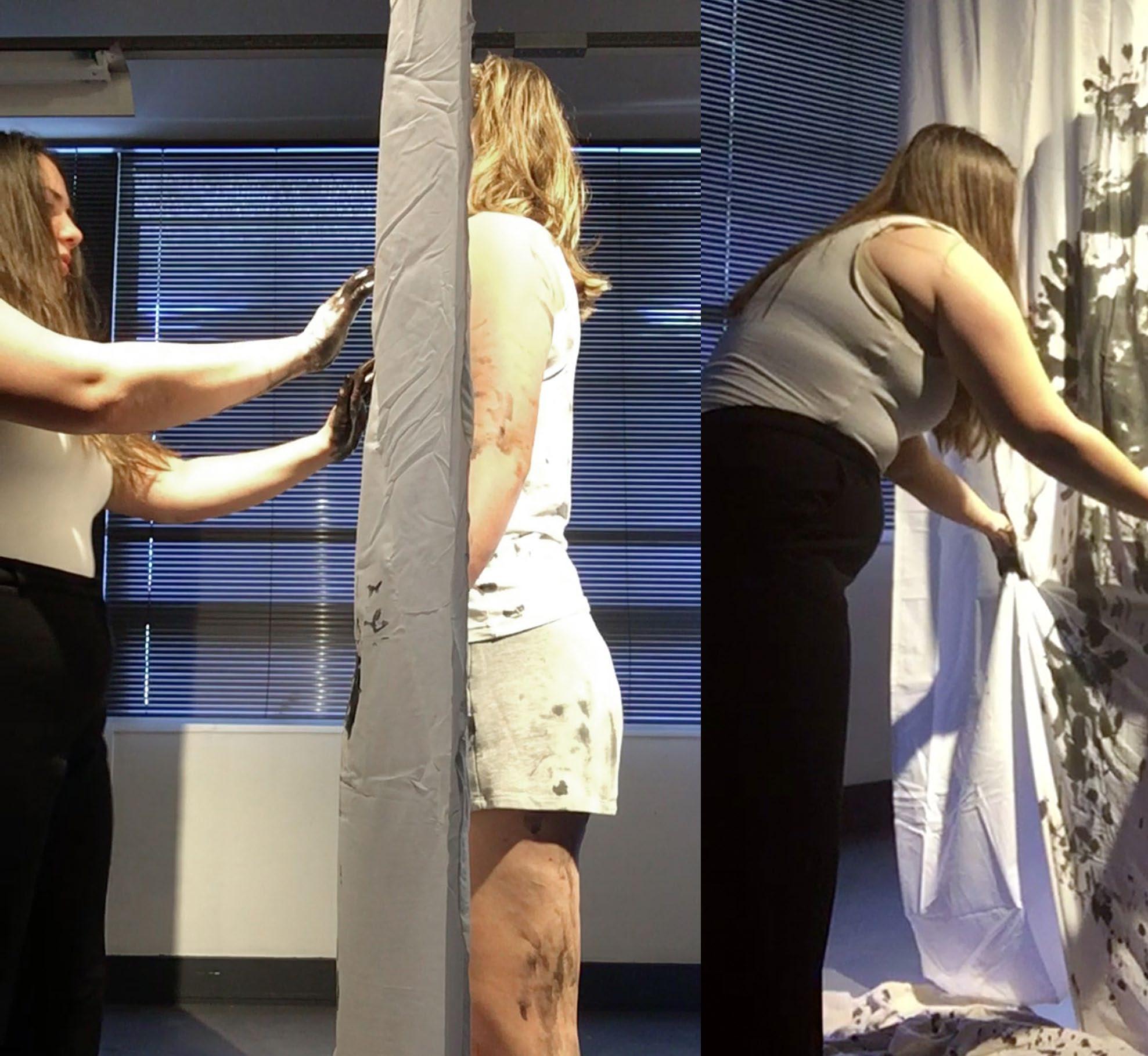
Contact is such a potent tool. This piece originally started with the desire to use the contact between me and another person to create a visual piece of art, and it evolved, becoming more conceptual. In viewing the final product, however, I feel it has returned to addressing to power of the contact between myself and my partner. Isolated as they are, each touch holds a great deal of weight, and the link created between myself, the fabric and my model in each moment of contact is simultaneously personal and exposed, demonstrating in each fleeting touch the power of physical connection between people.
Image: Emma Hughes. Video still from Filthy. Filmed performance, acrylic on sheet. 2020.
An afternoon to eat the rich explores the utopia of a world without capitalism, highlighting the need for community, healthcare and housing for all, which cannot exist in conjunction with the constructs of capitalism.
Image: Sophy Riggs. An afternoon to eat the rich. Oil and acrylic on calico, 120 x 300 cm. 2020.
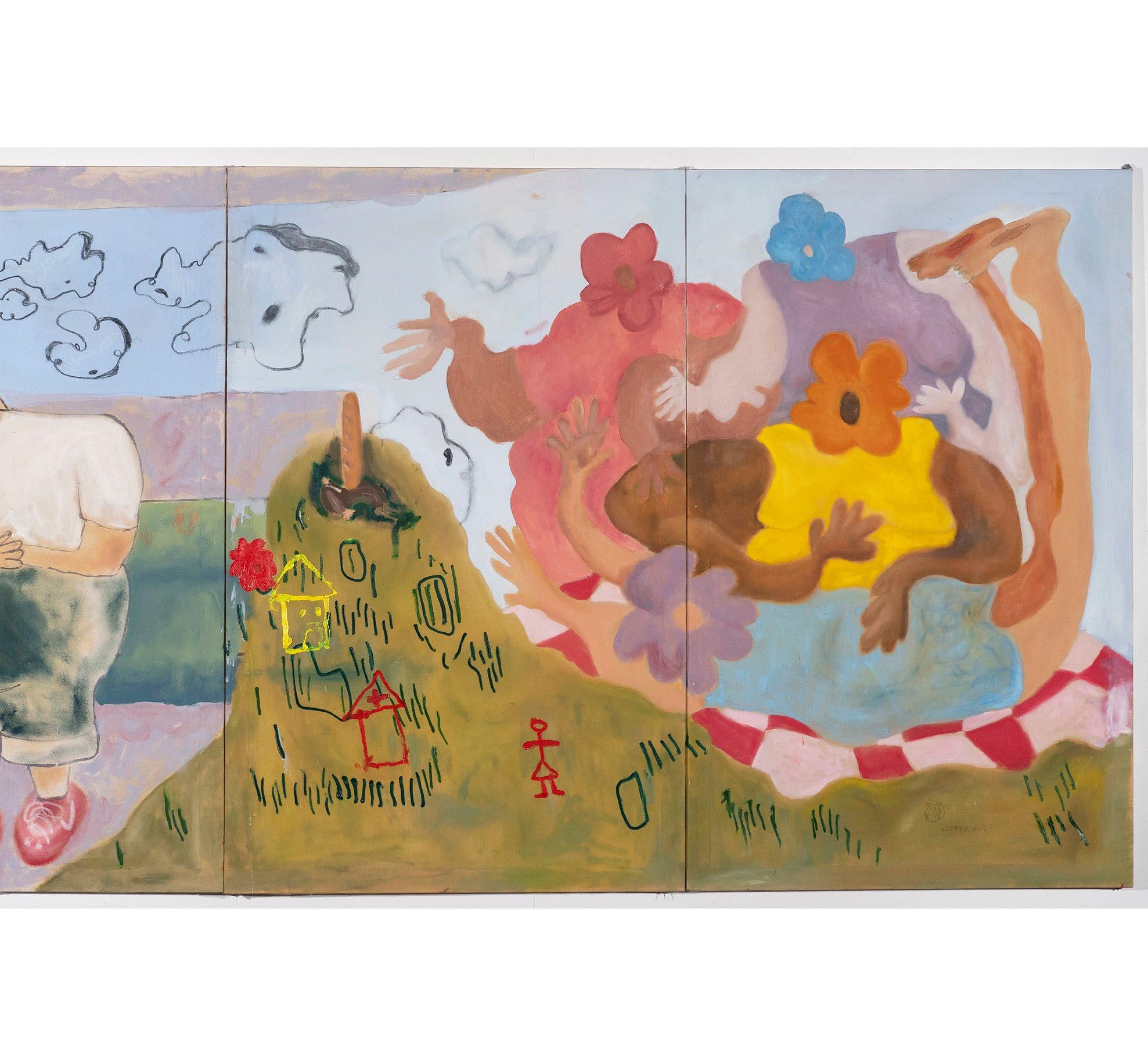
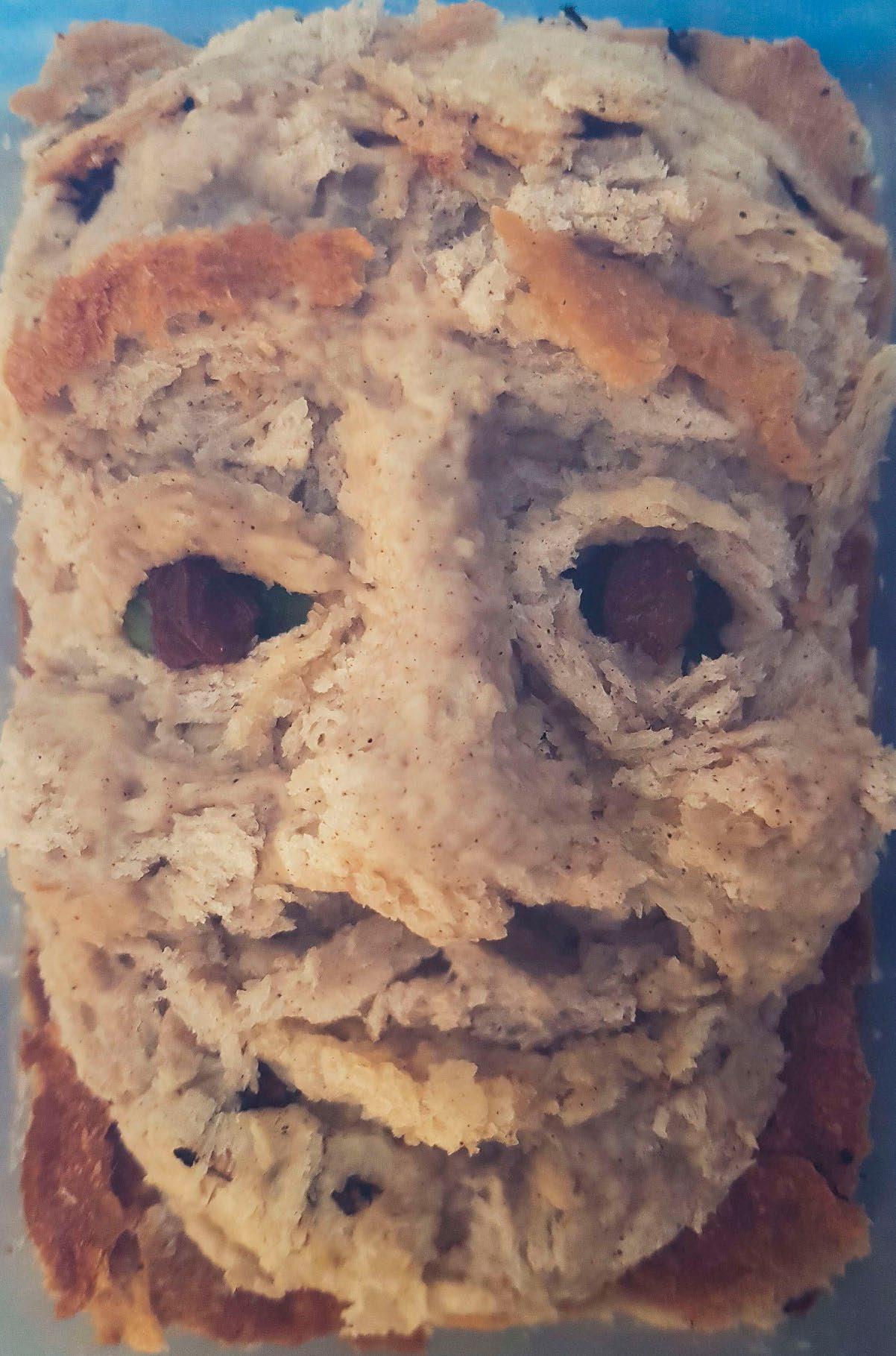
Bread Lenin is a sculpture of a human face made of bread and sealed in a transparent plastic container along with moisture-retaining cloth and a mould culture sample. Taking into account the subject of time and change central to the ARTF1053 unit, I have drawn my inspiration from the image of Lenin in the glass sarcophagus. A paradox, Lenin is simultaneously frozen in time as a physical body, and constantly re-invented as an ideological concept in the post-Soviet Russia. The element of time is an integral part of Bread Lenin, as the sculpture takes on a life of its own, transforming under the influence of both life in the form of mould, and entropy in the form of decay of organic matter. I have photographically captured this transformation on a daily basis, subsequently applying the skills learned from ARTF1053 to arrange the resultant images into a stop-motion film. The film is thus both the documentation of an art project and an independent artwork in itself. Bread Lenin the Movie is a meditative work capturing the transient nature of not only the human symbols and ideas, but of the body itself. As the human being changes under the influence of knowledge and experience accumulated in the course of their development, so does the Bread Lenin transform beneath the blossoming mould. Simultaneously, as each learning experience brings the human closer to their final moment, so does every motion of mould break down the structure of Bread Lenin, erasing the human likeness and reducing it to organic waste.
Image: Victor Malyarovskiy. (Left) Bread Lenin - Beginning. (Right) Bread Lenin - Intermediate. 2020.
This work evolved from influences within my personal environment, and from wider world events. Anxiety, stress and worry have never been so apparent in society, as life has evolved and changed in response to the pandemic. Watching people close to me struggle with anxiety has highlighted the need to slow down and reconnect, to ground ourselves in the now and embrace the moment we are in. The rushed pace and pressures of life can feel overwhelming. I wanted to create something that would offer a moment of stillness, of respite for the overwhelmed heart and mind. I felt driven to create a soothing environment, a place of refuge. It was within this mindset that the concept of a ‘serenity pod’ came about.
The hugging form of softly curving feathers creates a sheltered space within, exuding strength while honouring fragility. The textured spine gives a sculptural effect and mimics the spinal cord, communicating a sense of strength and stability. The simple pure lines are reminiscent of angel wings curving protectively inwards and offering a warm embrace. Metaphorically, a deeper significance of this overlapping softness is the representation of humanity’s need to feel interconnected and held, which are central concepts of this work. The ability to sit within the sculpture offers the audience the opportunity to engage with the work interactively and experience its comfort.
Image: Ciara Kelly-Gilligan. Serenity Pod. Paper, metal, wood. 2020.
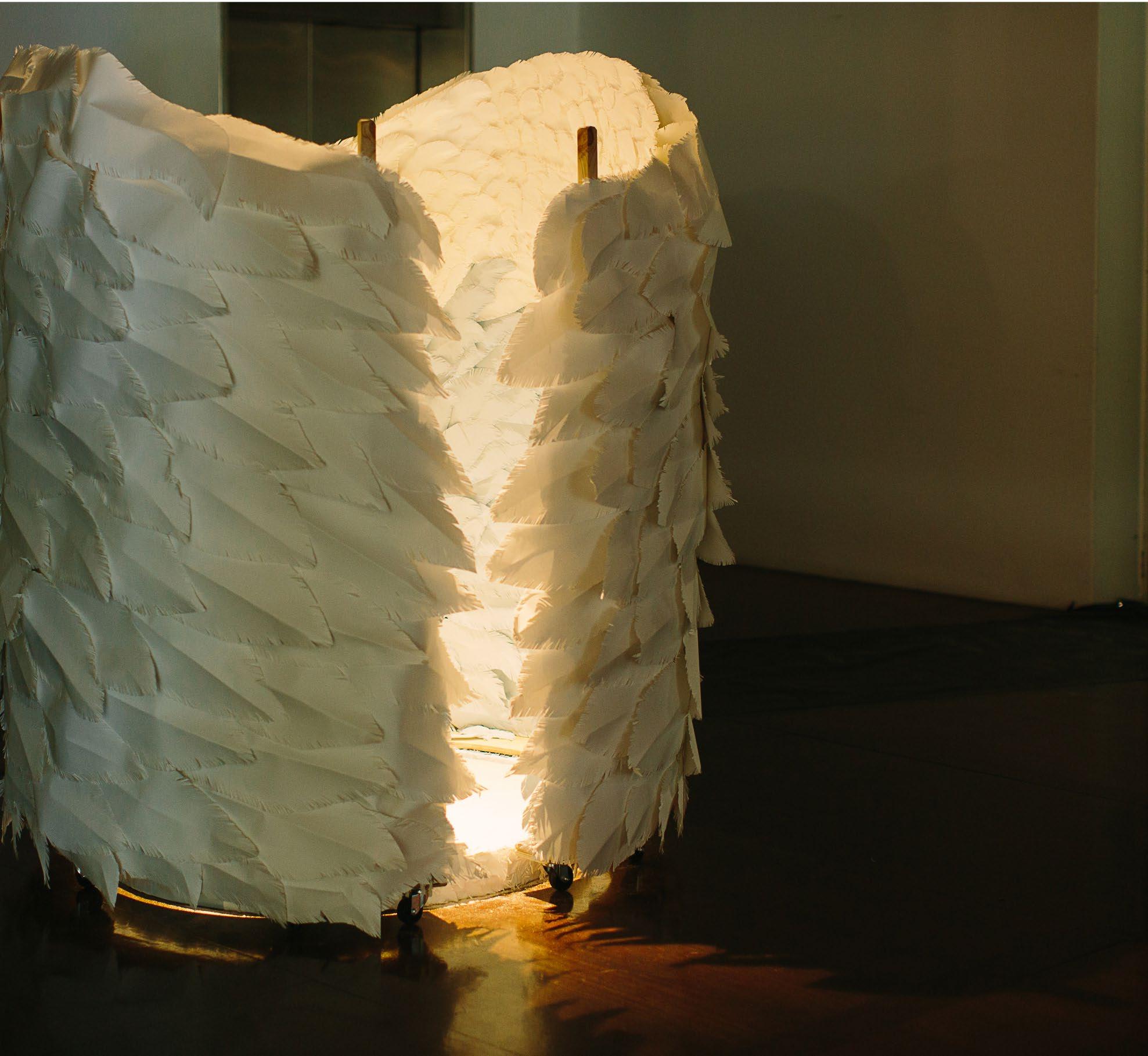
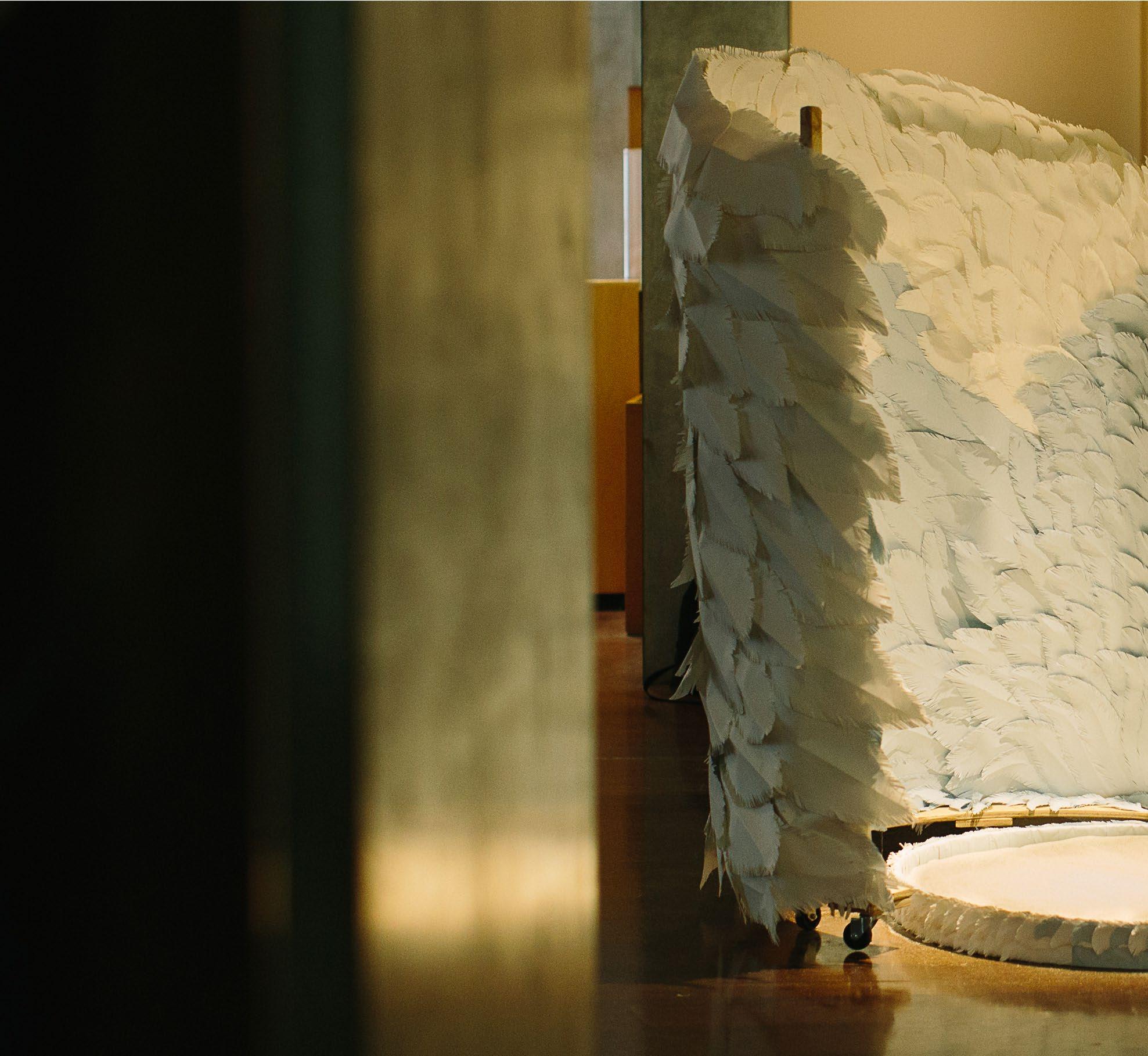
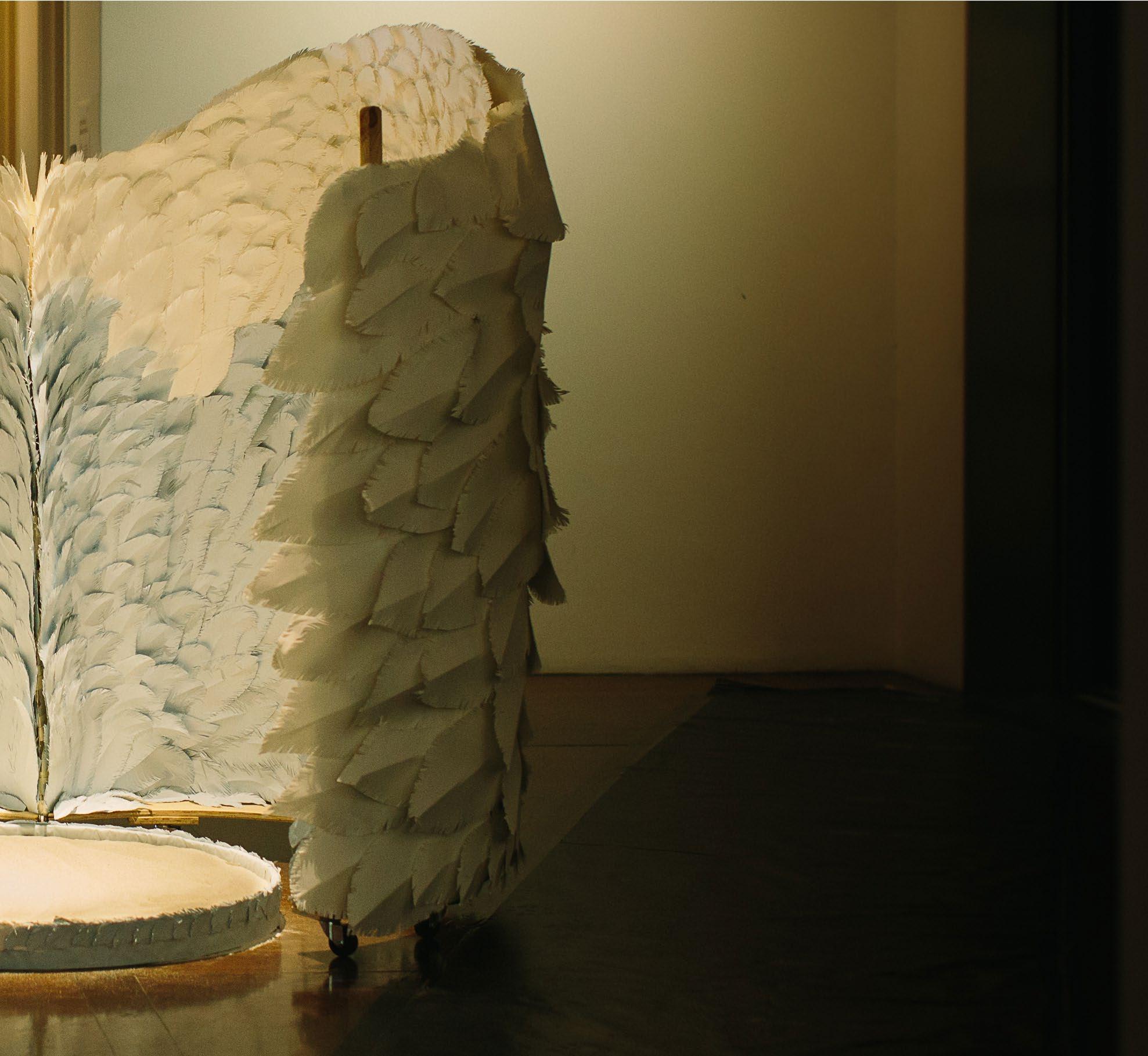
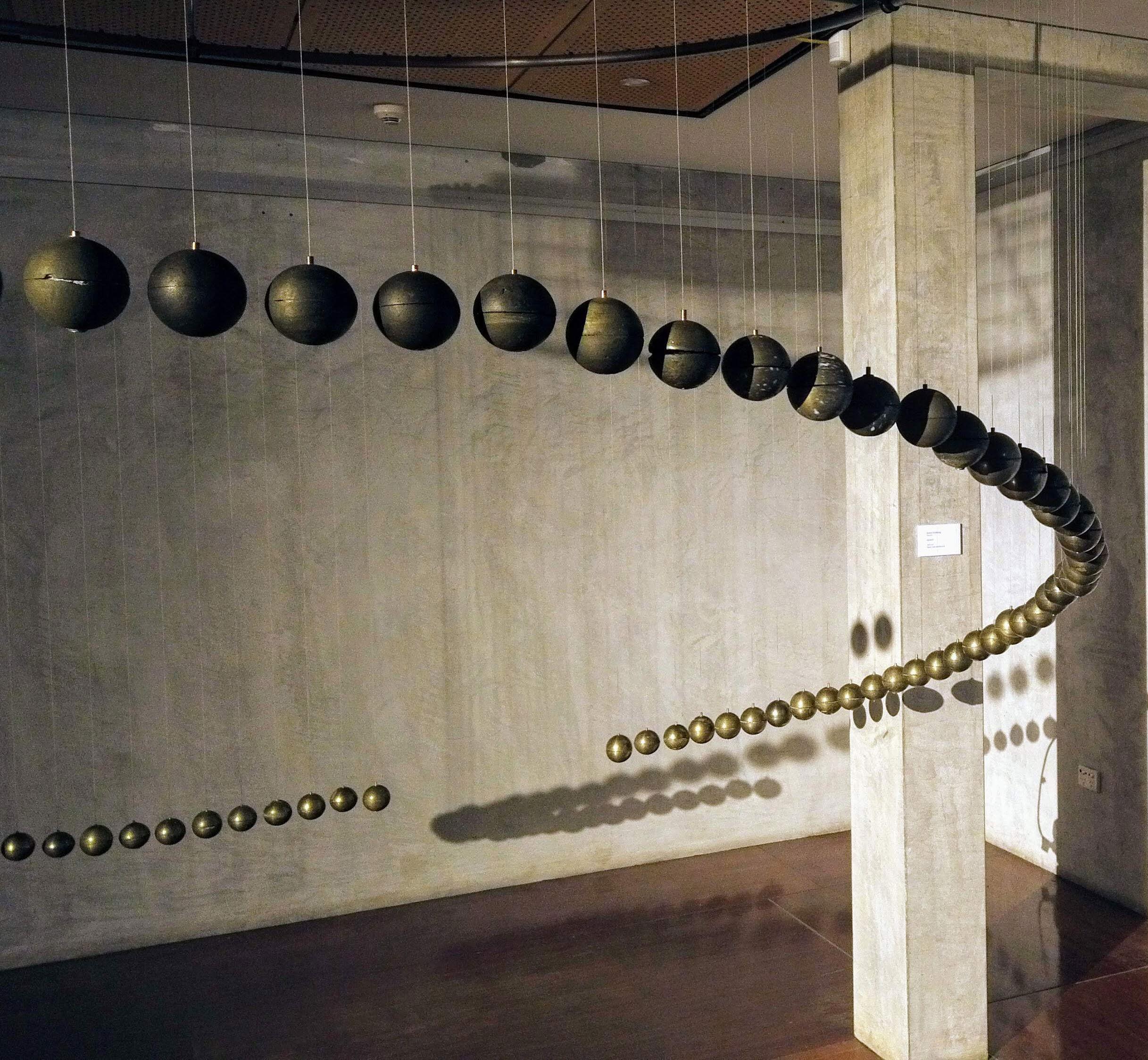
100 cast Jesmonite globes are suspended by wires and attached to a servo motor.
Each globe is finished to represent the ratio of the elements that compose a human body: 65 Oxygen, 18 Carbon, 10 Hydrogen, 3 Nitrogen and the remainder are trace elements.
Every human life has this ratio in common.
From the moment we are born we become isolated from each other. Race, religion, sexual orientation, gender: the non-reasons for discrimination are endless.
Genesis reflects our shared identity in response to isolation.
Image: James Dudding. Detail of Genesis. Jesmonite metalflex - brass, aramid, stainless steel, servo motor. 2020.
